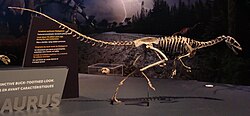| Noasaurids | |
|---|---|

| |
| Reconstructed skeleton of Masiakasaurus knopfleri, Royal Ontario Museum | |
| Scientific classification | |
| Domain: | Eukaryota |
| Kingdom: | Animalia |
| Phylum: | Chordata |
| Clade: | Dinosauria |
| Clade: | Saurischia |
| Clade: | Theropoda |
| Clade: | †Abelisauria |
| Family: | †Noasauridae Bonaparte & Powell, 1980 |
| Subgroups | |
| |
| Synonyms | |
| |
Noasauridae is an extinct family of theropod dinosaurs belonging to the group Ceratosauria. They were closely related to the short-armed abelisaurids, although most noasaurids had much more traditional body types generally similar to other theropods. Their heads, on the other hand, had unusual adaptations depending on the subfamily. 'Traditional' noasaurids, sometimes grouped in the subfamily Noasaurinae, had sharp teeth which splayed outwards from a downturned lower jaw.
The most complete and well-known example of these kinds of noasaurids was Masiakasaurus knopfleri from Madagascar.[4] Another group, Elaphrosaurinae, has also been placed within Noasauridae by some studies.[3] Elaphrosaurines developed toothless jaws and herbivorous diets, at least as adults.[5]
The most complete and well known elaphrosaurine was Limusaurus inextricabilis. At least some noasaurids had pneumatised cervical vertebrae.[6] Some are considered to have had cursorial habits.[7] Noasauridae is defined as all theropods closer to Noasaurus than to Abelisaurus.[8]
- ^ Cerroni, M.A.; Agnolin, F.L.; Brissón Egli, F.; Novas, F.E. (2019). "The phylogenetic position of Afromimus tenerensis Sereno, 2017 and its paleobiogeographical implications". Journal of African Earth Sciences. 159: 103572. doi:10.1016/j.jafrearsci.2019.103572. S2CID 201352476.
- ^ Averianov, A. O.; Skutschas, P. P.; Atuchin, A. A.; Slobodin, D. A.; Feofanova, O. A.; Vladimirova, O. N. (2024). "The last ceratosaur of Asia: a new noasaurid from the Early Cretaceous Great Siberian Refugium". Proceedings of the Royal Society B: Biological Sciences. 291 (2023). 20240537. doi:10.1098/rspb.2024.0537.
- ^ a b c Rauhut, Oliver W. M.; Carrano, Matthew T. (2016-04-22). "The theropod dinosaur Elaphrosaurus bambergi Janensch, 1920, from the Late Jurassic of Tendaguru, Tanzania". Zoological Journal of the Linnean Society. 178 (3): 546–610. doi:10.1111/zoj.12425. ISSN 0024-4082.
- ^ Andrew H. Lee & Patrick M. O’Connor (2013) Bone histology confirms determinate growth and small body size in the noasaurid theropod Masiakasaurus knopfleri. Journal of Vertebrate Paleontology 33(4): 865-876
- ^ Wang, S.; Stiegler, J.; Amiot, R.; Wang, X.; Du, G.-H.; Clark, J.M.; Xu, X. (2017). "Extreme Ontogenetic Changes in a Ceratosaurian Theropod" (PDF). Current Biology. 27 (1): 144–148. doi:10.1016/j.cub.2016.10.043. PMID 28017609. S2CID 441498.
- ^ Arthur Souza Brum, Elaine Batista Machado, Diogenes de Almeida Campos & Alexander Wilhelm Armin Kellner (2017). Description of uncommon pneumatic structures of a noasaurid (Theropoda, Dinosauria) cervical vertebra to the Bauru Group (Upper Cretaceous), Brazil. Cretaceous Research (advance online publication). doi: https://doi.org/10.1016/j.cretres.2017.10.012
- ^ Cite error: The named reference
:02was invoked but never defined (see the help page). - ^ Cite error: The named reference
:0was invoked but never defined (see the help page).